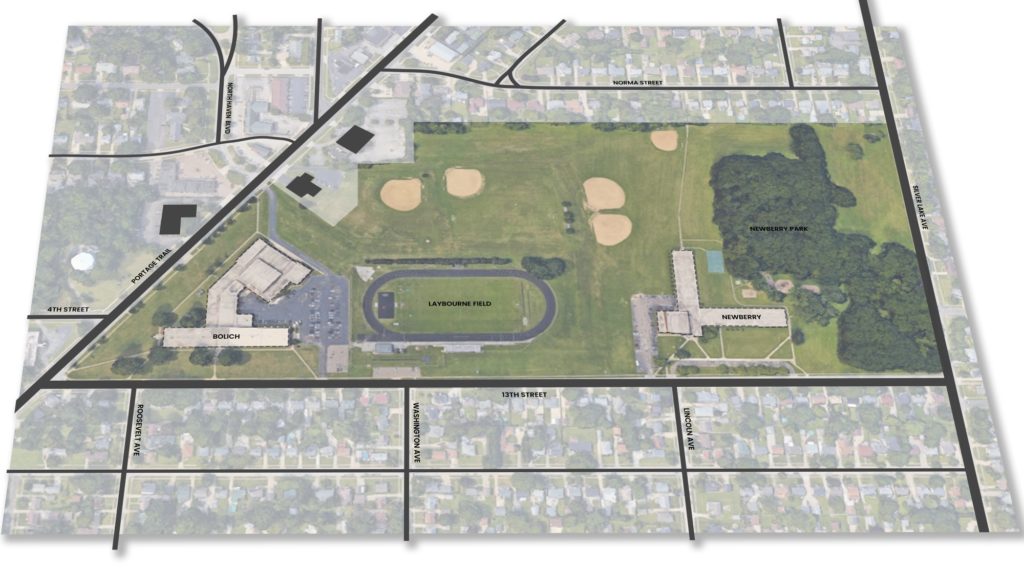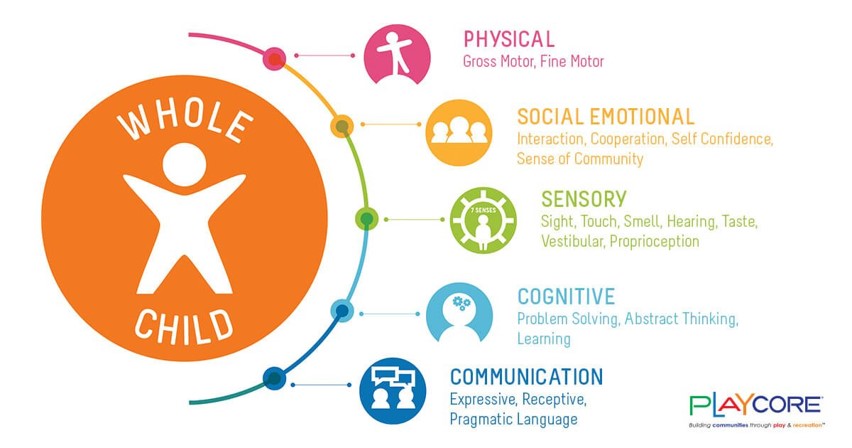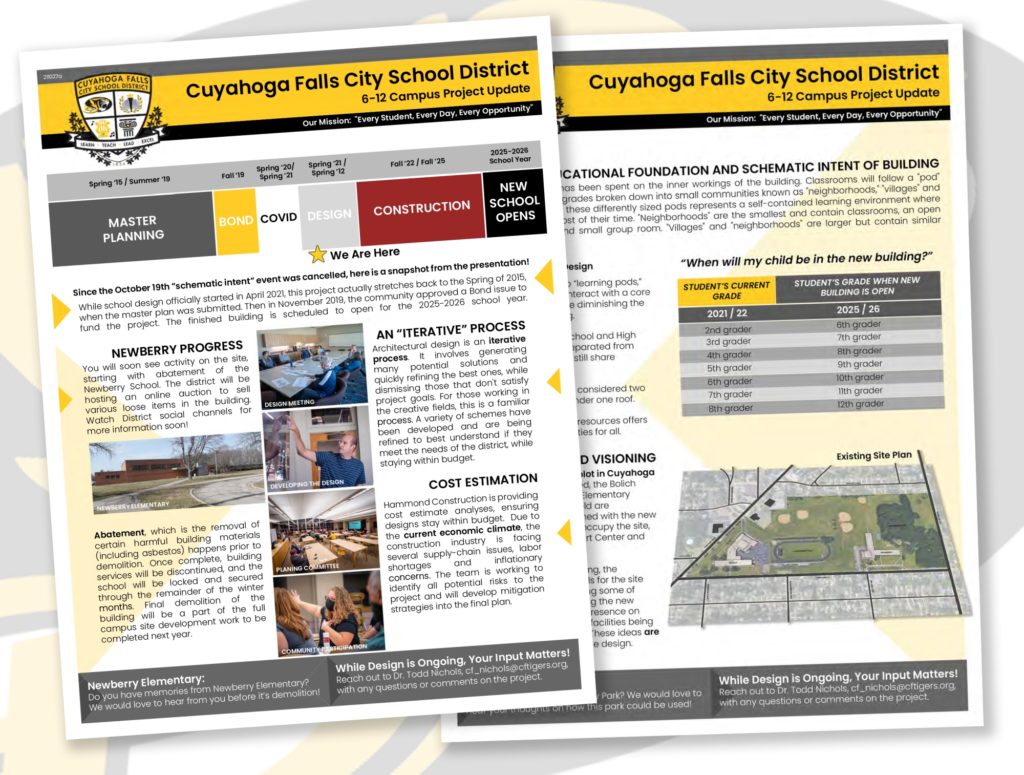Academic Design and Construction Update
Since the October 19th “schematic intent” event was cancelled, below is a brief snapshot from that presentation.
Progress continues on plans for Cuyahoga Falls’ new 6-12 school and stadium complex. The Cuyahoga Falls City School District, the Ohio Facilities Construction Commission (OFCC), Hammond Construction and ThenDesign Architecture have been engaging with the school district administration and staff, board members, community members, city officials, and various specialists through meetings, engagement sessions, surveys, and presentations. Each of these parties have helped to shape the design of the new school and are committed to creating a facility that provides strong, innovative programs for students, safe and secure learning environments, and a gathering place for the Cuyahoga Falls community.
The design process involves three major phases: schematic design, design development and producing the final construction documents. Schematic design involves the overall look of the building, preliminary floor plans and the layout of the building on the site. The design development phase includes refining the look, selecting materials, and designing the building systems.
A Cuyahoga Falls 6-12 Campus Planning Committee Meeting
Site Plan
The site is a 45 acre plot in Cuyahoga Falls, where the Bolich Middle school, the old Newberry Elementary, LayBourne Field and Newberry Park are located. Bolich Middle School (opened in 1954) was the first junior high school in the Cuyahoga Falls City School System. It became a middle school in 1983 and since then has housed grades 6, 7 and 8. Newberry Elementary School, which was originally built in 1956, is a single-story building that has been leased by Summit Christian School and Summit County Educational Services since 2005.
Bolich, Newberry and Laybourne Field are scheduled to be demolished with the new 6-12 building planned to occupy the site, along with a Performing Art Center and new athletic facility. During Educational Visioning, the community identified goals for the site, which included maintaining some of Newberry Park and allowing the new building to have a visual presence on Portage Trail, with athletic facilities being located towards Newberry Park. These ideas are being incorporated into the design.
The Bond Process and Educational Visioning
While design officially started in April after an Educational Visioning Session, this project stretches back to the Spring of 2015, when the school District filed a master plan with the Ohio Facilities Construction Commission. In November 2019, the Cuyahoga Falls community approved a Bond issue that provided $80.6 million of the project, while the OFCC will contribute $33.2 million to the overall project. State funding was released to the district in May 2021, another large milestone that allowed all the team members to officially begin design.
The new facility is scheduled to open for the 2025-2026 school year. The Mayor of Cuyahoga Falls, Don Walters has called this project, “the missing link of the city,” in an interview earlier this year. The much-anticipated project will offer residents and students a modern environment and expanded educational opportunities.
Cuyahoga Falls City School District Educational Visioning
Architectural Design is an Iterative Process
Starting in April 2021, ThenDesign Architecture, the Cuyahoga Falls City School District and the OFCC have been developing schematics for the new structure. Throughout the spring and summer, a variety of engagements with community groups and educators have taken place. This has allowed the team to receive feedback from community members, teachers, and administrators that are being actively incorporated into the design process.
Architectural design is an iterative process. It involves generating many potential solutions, then quickly refining and testing the best ones, while dismissing those that don’t satisfy projects goals. For those working in the creative fields, this is a familiar process, and the development of the new school is no different. A variety of schemes have been developed, tested, and refined to best understand if they meet the needs of the district, while staying within budget.
We look forward to sharing more specifics on the 6-12 campus in the coming months.
Development for "The Whole Child"
Educational Foundation of Building
A great deal of time has been spent on the inner workings of the building with the schematic intent for the academic design being outlined. Classrooms follow a “pod” structure, with various grades broken down into small communities known as “neighborhoods,” “villages” and “communities.” Each of these differently sized pods represents a self-contained learning environment where students will spend most of their time. “Neighborhoods” are the smallest and contain classrooms, an open collaborative space and small group room. “Villages” and “communities” are larger but contain a similar academic design.
Educational research indicates that each person can maintain 150 meaningful social relationships at once. Dividing spaces in this way allow students to remain with a core group of their peers. This diminishes the overall building scale, while allowing all grades to efficiently share the common areas such as student dining, the gymnasiums, and performing arts center.
Examples of the neighborhoods include the three-6th grade learning “neighborhoods.” These small educational pods are separated from the middle and high school. This way sixth graders enjoy a welcoming and safe environment as they navigate the crucial transition out of elementary school. This new pod environment allows them to acclimate naturally to the new educational environment, while eliminating another jarring facility transition in future grades.
Similarly, the middle school “villages” are separated from the high school pods and the middle and high school have separate entries. It is best to think of this complex as two separate buildings under one roof. While there are opportunities for to share common spaces, students will remain separated in their academic areas but still benefit from pooled educational resources in a single building. This is the direction that many school districts are moving in and a lot of research demonstrates its effectiveness in public education.
A Design Team Meeting
The Role of a Construction Manager
As we move through the phases of design, Hammond will provide cost estimate analyses, ensuring the design stays within the financial commitment made to the community. With the current economic climate, the construction industry is facing several supply chain issues, labor shortages and inflationary concerns. Our team is currently working to identify all potential risks to the project, and will develop mitigation strategies into the final plan.
You will soon see activity on the site, starting with abatement of the Newberry School. In the next few months, the district will be hosting an online auction to sell various loose items in the building. The abatement of the building will follow, which includes the removal of specific materials prior to demolition of the facility. Once abatement is complete, the building services will be discontinued, and the school will be locked and secured through the remainder of the winter months. Final demolition of the building will be a part of the full campus site development work to be completed next year.
When will my child be in the new building?
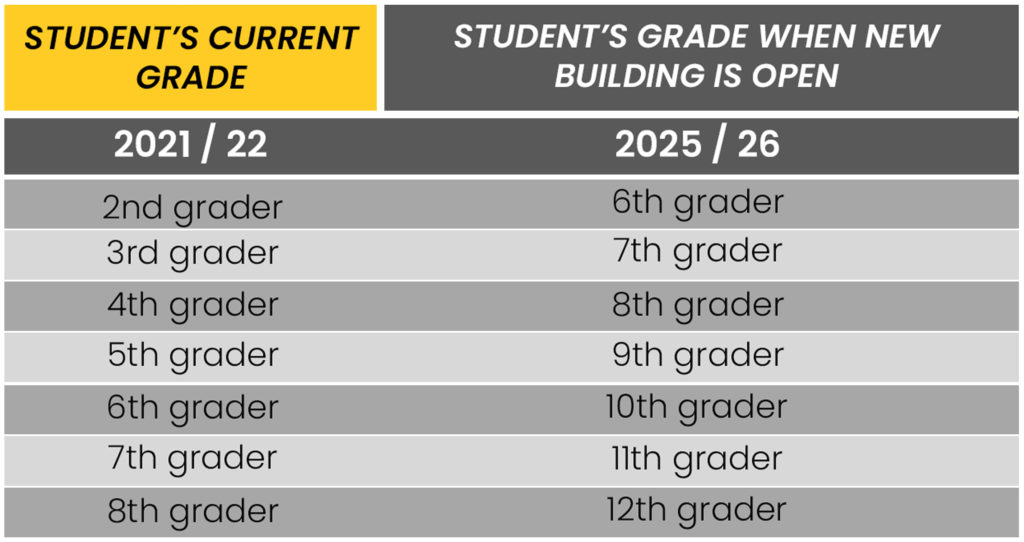
Next Steps:
We look forward to releasing more information on the building as details around the floor plan, interior spaces and exterior renderings are developed. In the meantime, if you have specific questions, feel free to reach out to: cf_nichols@cftigers.org.
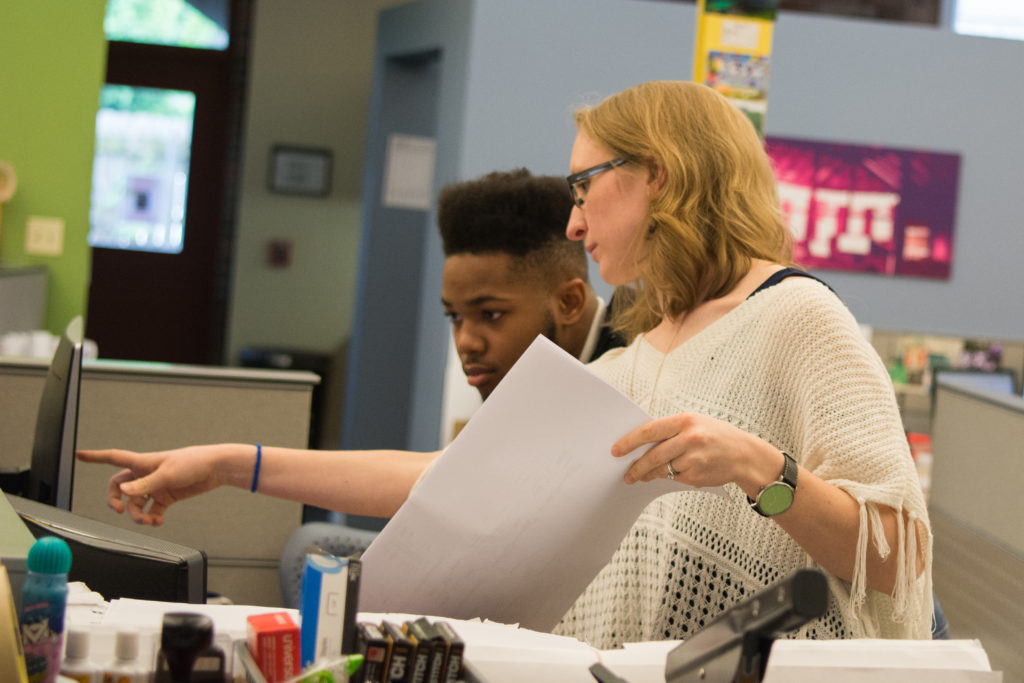
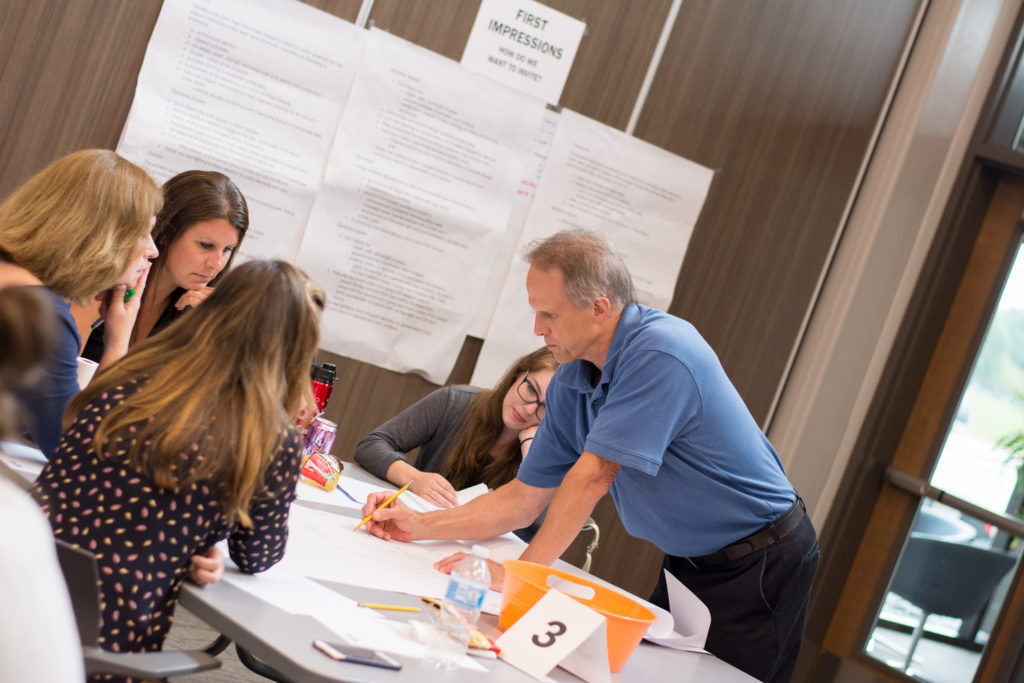
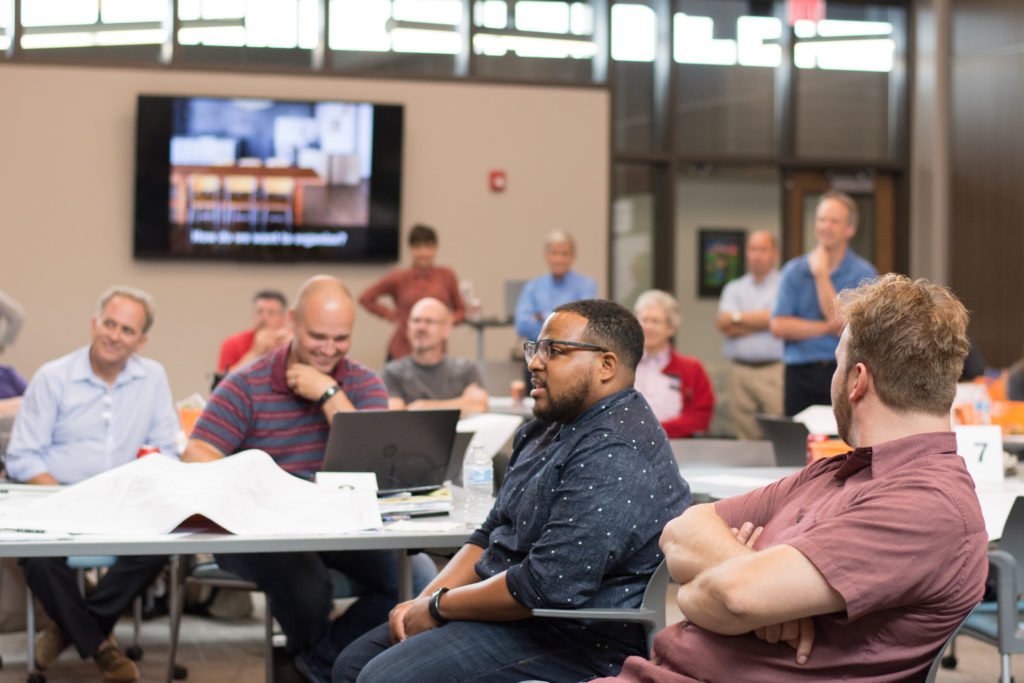
Let’s work together to make education better. Interested in speaking with us? Get in touch!

Ryan Caswell
Communications
Get our newsletter with insights, events and tips.
Recent Posts:
Brunswick High School Senior Seminar Presentations
New Mentor High School Baseball Field Opens
North Ridgeville Visual Preference Exercise
Meet the Designers: Katherine Mitchell
Garfield Heights High School Stadium Groundbreaking

Ryan Caswell
Ryan is a communications specialist who is passionate about using digital media to further the goals of organizations and communities in Northeast Ohio. With a background in construction and a degree in architecture, he spent over a decade in corporate video production and brings this mindset to videography, editing, photography and content marketing. He is passionate about supporting the arts, and can be found hiking in the parks system.
